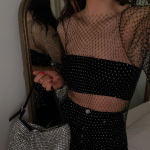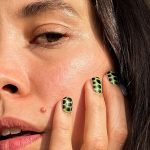Katie Holmes has occupied space in the public eye for more than 20 years, ever since she sent in a casting tape for the role of Joey Potter in Dawson’s Creek. The actress skipped her in-person test to instead play Lola in her high school’s rendition of Damn Yankees yet still landed the series’s covetable lead role. Since then, every move she’s made has been placed under a microscope, from the relationships she’s been in to the cashmere bras she’s worn. “It’s an interesting way to live,” she tells me over Zoom. Holmes is sitting comfortably in her bed while sporting casual-luxe loungewear and her signature messy bun. “It was something that I wasn’t necessarily ready for at age 18.” Coming from Toledo, Ohio, where she grew up in a close-knit and very supportive family, moving away, and almost immediately becoming a household name was an adjustment. “I think I developed a real protective layer for myself,” she says.
According to the 43-year-old, that tough skin came as a direct result of pursuing work in the entertainment industry, which she says is built on intense competition that can “create havoc for a person.” And it’s hardly been rendered unnecessary. On the contrary, having an additional line of defense in her back pocket has been a blessing, allowing the actress to dodge the curveballs her career and personal life have thrown her way. By doing so and always managing to emerge unscathed, Holmes is finally in a position of control, both in her own narrative and the ones she creates on film.
Since the pandemic started in 2020, she has finished production on two projects that she wrote, directed, produced, and starred in. Alone Together, which came out in July, was the product of her experience in lockdown in New York City and upstate New York where she quarantined throughout its early stages. “I remember even in the scariest times of lockdown thinking that this is so much to grasp, and it’s so big, and [yet] we’re all [still] talking to each other trying to put the puzzle pieces together of what we were hearing and the updates every morning,” she recalls. “I felt like, wow, this is really interesting how humanity is coming together.” In her mind, she wanted to tell a story that grasped the gravity of the situation without adding more terror to it. There was already enough of that in the world. “I really just wanted movies that I knew the ending of and that were funny and weren’t stressful,” she says. “That is what I want to put out in the world. I want to put some hope out there. I want to put some joy out there.” In the end, Alone Together became something of your typical “girl meets boy, girl loses boy, girl gets boy” story, albeit one set during a global pandemic. Unlike other tales from that harrowing period in time, it touched on the rare, beautiful moments in lockdown, when people leaned on each other—friends, family, or in this case, total strangers—to survive.
The other project she developed, a film adaptation of Kathleen Tessaro’s novel Rare Objects, is set to be released spring 2023. Both pieces were shot entirely during the pandemic at various stages of its grasp on our world. “It was really exhilarating,” Holmes says of being in a position of control during a time of such powerlessness. “Having the ability to play a scene and be able to say, ‘Oh, let’s change this line,’ or ‘Say that,’ or ‘Let’s just try this,’ was great because I knew the day, so I knew what we had to achieve. So it was like, Okay, I think we can take the time for this to play a little bit, or No, we don’t need to [waste] time [doing] that now.” After often being at the whim of a director’s vision herself, finally getting the opportunity to step behind the camera and make those decisions, both big and small, was an exciting challenge. “Some days were great, and some days I messed up,” she says. “But I think that is something you get the more you do it, the more you learn.”
At the same time, Holmes is conscious of the importance of being flexible with her vision and knows that in some instances, she’ll need to waive her authority. “I’m in the position of control, and that’s something that I respect. That being said, the true process is something bigger than everybody involved in a very true way because there are so many pieces that have to come together,” she says. “Now you have to be the one in charge saying yes, no, yes, no, and this is the vision I want. But I also depend on everyone.” Without that collaboration, her dream for the project could never come to fruition. Certainly, it wouldn’t become the best version of itself. “I always say to people, ‘Please read this, and if it inspires you, I want you to do it. If it doesn’t, I’m okay. But if it does, then bring it all.’ That way, we can be fully in it,” she says. “We’re all trying to make the best movie, and we become partners in a way.” So while, yes, her word is the final one, it’ll never be the only one that’s heard.
It’s the same for her writing process. “I’m writing a script right now, and I’ve gotten it to a pretty good place that I feel very happy about, and it’s taken a while,” Holmes explains. “In this space, yes, I feel in control because I’m researching, and I’m doing this, and I’m doing that, so I’m totally in control of what I want to say. But that will change because then I get notes. And that’s okay.” For her, that give-and-take is vital in the creative process—it is what’s needed to get the best possible result. “I like starting in one place and going to another,” she says. “And I also know that I’m constantly learning, and I like to learn from other people. So while I respect the position [of control], and I hold it, it’s more about creating an environment where everybody can do their best work.”
On a Holmes set, when things get to be too much, she has an offbeat solution: “I’m always like, okay, let’s have a dance party,” she says. “It’s getting a little stressful in here.” With that sort of ethos on set, it’s no wonder that so many of the people she works with come back for more. See: Derek Luke, who stars in both Alone Together and Rare Objects; casting director Avy Kaufman, who booked her in The Ice Storm (Holmes’s first film credit) and cast a movie Holmes directed called All We Had; and Brie Welch, Holmes’s personal stylist, who worked on both this cover shoot and the costumes on Rare Objects.
Holmes’s relationship with Welch is especially collaborative. “Brie’s got impeccable taste; she’s quite an artist,” she says of the stylist and creative consultant, who has worked with brands such as Wolf Circus, Simon Miller, Levi’s, and Bulgari, to name a few. According to Holmes, working with Welch has been something of an educational journey as well as an inspiring one. “She finds things that I’m like, Wow, how did you do this?” Welch’s ability to discover just the right piece down to the smallest of details is what makes them a perfect match. Like Welch, Holmes too is incredibly focused on the little things, especially when it comes to fashion and costumes. “One of my favorite things about making movies is [creating] costumes when you’re [developing] a character,” she says. “I’ve worked with costume designers where [something as small as] the button on a shirt [is used to] say so much about a character, or maybe just for me, it gives me something to hold on to.” Welch gets that, Holmes says, reminiscing about a moment from Rare Objects when the stylist nailed a minor character’s costumes. “She was so specific. It was incredible,” she says. “Every single costume, I was like, Oh, wow. Yes, that’s exactly right. I really understand who this person is.”
The two agree that dressing, both for on-screen moments and off-screen ones, for high-publicity events and everyday occasions, is an art form as well as a device for communicating one’s feelings and emotions. “I think what we wear is an opportunity to create [a narrative],” Holmes says. “You’re creating your look for the day, you’re creating how you feel, and you’re revealing that [to the world].” For her, putting together an outfit is about more than simply combining one garment with another. Instead, it’s an amalgamation of everything around her, including the street style in her neighborhood of SoHo, where the looks are as outrageous as they are enviable; the brands that inspire her, specifically, Gabriela Hearst and Chloé; and her evening plans. “When I’m going out to meet my friends, I like to look cool so that they think I’m cool. And that’s usually the extent of my dress code,” she says. On a macro level, though, Holmes describes her ideal aesthetic as comfortable, classic, and elegant, a trio that no doubt plays into why people are so enamored with the actress’s off-duty style. “I really just enjoy fashion, and I enjoy clothing.”
For Holmes, personal style is just that—personal. In other words, it has nothing to do with what’s trending at the moment, so much so that when I asked her what trends she’s loving for fall, she whispered back, “What are the trends for fall?” Instead, she solely invests in clothes that make her feel good. The immense media attention that her outfits garner never influences her either—and immense it is. From the sweatpants she throws on for dance class to the $1680 now-viral cardigan she wore to casually go school shopping with her daughter, every last one of her looks is dissected, down to the tiny nose ring she debuted earlier this year. “That becomes a little bit too much,” she tells me. “It’s not really my thing.” Being photographed, like everything else that she’s been subject to during her career, is just a part of the job. “If I happened to be [photographed], it happens, but I’m not going out [with that intention.]”
One way she goes about regulating what’s posted and what’s not is by steering clear of most social media. “When I started, there was more of a sense of control,” she explains. “You were creating images, you were doing photo shoots, you were creating different pieces. And it was all because you were promoting a movie or a show. It was pretty simplified.” Nowadays, she says that social media has created an “atmosphere of chaos,” where you don’t know where images come from or what they intend to promote. “It’s a bit of a lot,” she says. Because of that, she only uses it, specifically Instagram, to post for promotional purposes—and sparingly.
She didn’t learn these lessons right away. Like with anything in life, there was trial and error involved. But eventually, Holmes built up an immunity to those aspects of her life and career that are outside of her jurisdiction. In hindsight, she wishes she could tell that girl who left Toledo, Ohio, at the age of 18 to pursue a dream of becoming an actress to stop worrying about having everything figured out and just enjoy it. “The industry is set up for that tough competition and that sense of I didn’t get it or I’m not enough or that constant They didn’t want [me],” she says. “Over time, you start to realize the ebb and flow of our industry. So it’s all about just telling yourself that you’re okay.” Twenty-four years after her big break, Holmes sees everything clearly. And with that view, she has all the power.
Photographer: Olivia Malone
Stylist: Brie Welch
Hair Stylist: DJ Quintero
Makeup Artist: Genivive Herr
Manicurist: Ada Yeung
Set Designer: Elaine Winter
Director of Photography: Clarence Fuller
Exec Creative Director: Alexa Wiley







